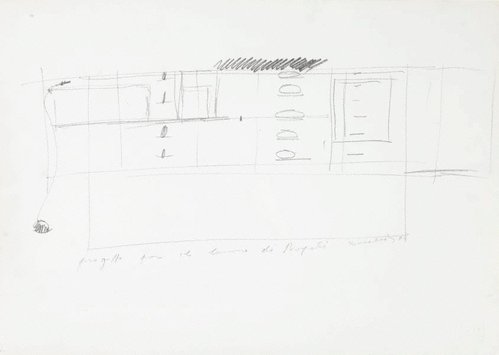
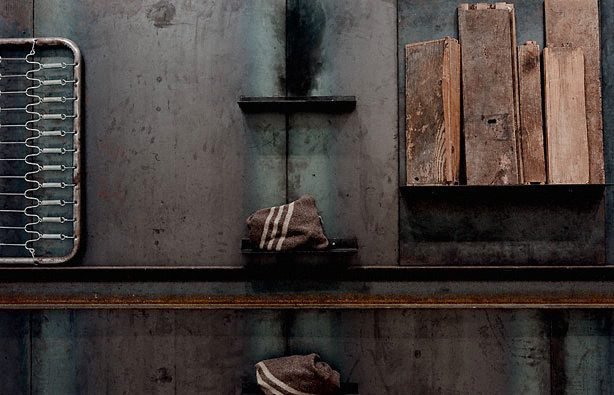


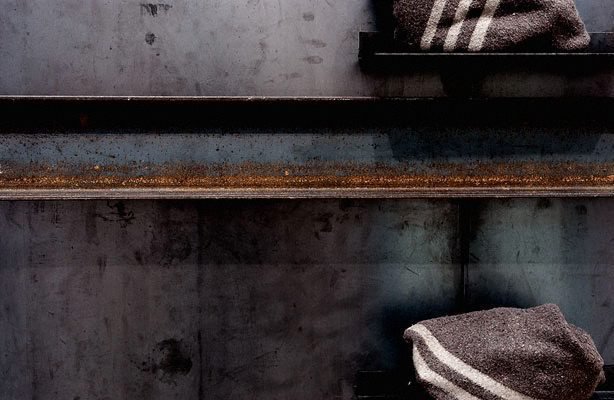

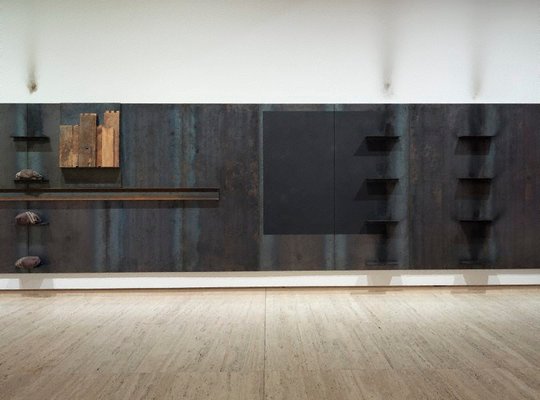
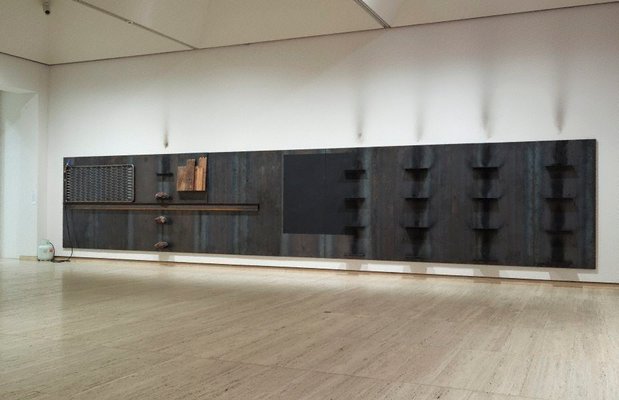
-
Details
- Date
- 1987
- Media category
- Installation
- Materials used
- 12 steel panels, steel bed frame, propane gas torch, steel girder beam, 21 steel shelves, 3 fabric bundles, 4 wood pieces, paint, soot, fire
- Dimensions
-
201.0 x 1093.0 x 19.5 cm overall
:
a-l - 12 steel panels, 201 x 91 x 4 cm, each panel
m - girder 'I' beam, 14.3 x 489.5 x 6.5 cm
n - bed frame, 80 x 189.7 x 3.5 cm
o - large shelf, 100 x 70 x 15.4 cm
p - wood piece no.1, 49.2 x 17 x 11.6 cm
q - wood piece no.2, 63.1 x 19 x 2.5 cm
r - wood piece no.3, 49.5 x 7.2 x 2.1 cm
s - wood piece no.4, 66.5 x 18.5 x 3.3 cm
t-mm - 20 small shelves, 4 x 40 x 13 cm, each
nn - gas bottle, 48 x 103 cm, diam
oo - gas burner and hose, 25 cm, burner length
oo - gas burner and hose, 380 cm, hose length
pp-rr - 3 cloth bundles, 18 x 25 x 15 cm, approx each
- Signature & date
Not signed. Not dated.
- Credit
- Mervyn Horton Bequest Fund 1988
- Location
- Not on display
- Accession number
- 393.1988.a-tt
- Copyright
- © Jannis Kounellis
- Artist information
-
Jannis Kounellis
Works in the collection
- Share
-
-
About
In 1967 a number of artists in Rome formed the arte povera group, with Jannis Kounellis as one of the key members. Literally the name derived from their use of poor and often discarded industrial materials rather than the traditional use of expensive oil paint, bronze or marble. This is something that they had in common with American minimalists but beyond the use of found materials they could not have been more different. The Americans were anxious to differentiate themselves from European traditions by eschewing all references beyond the physical qualities of the material. This was a logical extension of Clement Greenberg’s vision of autonomous art objects that are what you see – no more, no less. The arte povera artists on the contrary filled their work with poetic references to history and mythology, and very commonly to the relationship between nature and culture.
Kounellis’ ‘Untitled 1984/87’ is one of his most important works and it includes many of the ideas that permeate his art and arte povera as a whole.1 The work has a clear narrative that moves from left to right. The burning gas flame on the left represents the transformative power of fire and has alchemical associations.2 Literally it is the element that changes the physical state of materials from solid to liquid to gas and can be used to represent passage from material to spiritual and the cycle of life and death. The flame is attached to a bed frame, which is formed to exactly fit a sleeping body. It is the place where we are conceived and born, where we dream, where we make love and with luck where we die. So far then we have a story about human life; next we find fragments of household furniture, a house beam and bundles of objects wrapped in pieces of grey blanket. The domestic and the traveller are invoked: two aspects of our life and our journey through it.
In the centre of the work is a matt black square, a direct reference to Kasimir Malevich, an artist Kounellis admires greatly.3 The suprematist ‘Black square’ 1915 in Malevich’s terms contained opposites, in the form of a nihilistic statement about the end of representation and at the same time a window onto infinity and a space for meditation. In late modern art this emblematic square invariably suggests transcendence or the often wistful acknowledgment of its impossibility. Kounellis also admired Yves Klein, and like Klein he was interested in the idea of an immaterial void or spiritual dimension to which humanity might aspire. The symbolism of fire in transforming matter is related to this quest. The remainder of the panels are filled with orderly rows of shelves, above each of which is a sooty trace of fire. In the port city of Piraeus (near Kounellis’ birthplace) is a cemetery where oil lamps burn on each grave as a token of the passage of the spirit, and it is reasonable to assume that this is the meaning Kounellis wants us to take from the work. This is the end of the story but perhaps the fire at the left of the work speaks of a new beginning.
1. This work was first reserved by the AGNSW in 1986, when it was displayed at Anthony d’Offay Gallery in its 1984 version. In 1987 it was destroyed in a fire in Chicago, where it was then being displayed. The artist recreated the work in 1987 but it was not finally acquired until it was brought out at the time of the 1988 Biennale of Sydney
2. Thomas McEvilley in Mary Jane Jacob & Thomas McEvilley, ‘Jannis Kounellis’, Museum of Contemporary Art, Chicago 1986
3. McEvilley 1986© Art Gallery of New South Wales Contemporary Collection Handbook, 2006
-
Exhibition history
Shown in 3 exhibitions
1988 Australian Biennale: from the Southern Cross: a view of world art c.1940-88, Art Gallery of New South Wales, Sydney, 18 May 1988–03 Jul 1988
1988 Australian Biennale: from the Southern Cross: a view of world art c.1940-88, National Gallery of Victoria [St Kilda Road], Melbourne, 04 Aug 1988–18 Sep 1988
Jannis Kounellis., Ionion, Port of Pireus, Athens, Athens, 1994–1994
Jannis Kounellis Retrospective, Museo Madre, Naples, 22 Apr 2006–04 Sep 2006
Jannis Kounellis Retrospective, Kunstmuseum Liechtenstein, Liechtenstein, 20 Oct 2006–21 Jan 2007
-
Bibliography
Referenced in 18 publications
-
Bernard Blistène, Catherine David and Alfred Pacquement, L'Epoque, la mode, la morale, la passion, Paris, 1987, (illus.). reproduction of 1984 version
-
Anthony Bond and Victoria Lynn, AGNSW Collections, 'Contemporary Practice - Here, There, Everywhere ...', pg. 229-285, Sydney, 1994, 258 (colour illus.). full reproduction plus details
-
Anthony Bond, Contemporary: Art Gallery of New South Wales Contemporary Collection, 'Objects and associations', pg.332-381, Sydney, 2006, 10 (colour illus.), 350, 351 (colour illus.), 430. reproduction on pg.10 is a detail
-
Anthony Bond, Look, 'Marriage rites', pg.28-31, Sydney, Jul 2008, 30 (colour illus.).
-
Eduardo Cicelyn and Mario Codognato (Curators), Kounellis: Naples, MADRE, Museo d'arte contemporanea Donnaregina, Milan, 2006, 206-7 (colour illus.). reproduction of 1984 version
-
Lynne Cooke, Jannis Kounellis, 'Luminous Penumbra', unpaginated, London, 1986, (illus.). pl.2, reproduction of 1984 version
-
Rudi Fuchs and Piet de Jonge, The iron window, Eindhoven, 1985, (illus.). reproduction of 1984 version
-
Mel Gooding, Art Monthly (U.K.), 'Kounellis; Hayman', pg.11-13, London, May 1986, 11.
-
Wulf Herzogenrath (Editor), Raum, Zeit, Stille, Cologne, 1985, (illus.). reproduction of 1984 version
-
Mary Jane Jacob, Kounellis, 'Kounellis', pg.167-207, New York, 1990, 169, 180-1 (colour illus.), 183 (illus.). pl.nos.123 and 125, cat.nos. 94 and 99 as Untitled 1986. Reproductions are installation views of 1984 version with no gas cylinder installed at 1015 West Jackson Street, Chicago 1986.
-
Bruce James, Art Gallery of New South Wales handbook, 'Western Collection: Paintings and Sculpture', pg. 17-77, Sydney, 1999, 76 (colour illus.). reproduction is a detail
-
Thomas McEvilley, Jannis Kounellis, 'Mute prophecies: the art of Jannis Kounellis', pg.15-174, Chicago, 1986, 144, 146-7 (colour illus.). pl.107, reproduction of 1984 version
-
Musee d'Art Contemporain de Bordeaux, Jannis Kounellis: œuvres de 1983 à 1985, Bordeaux, 1985, 40 (illus.). this work is not in this exhibition but is reproduced in the catalogue, reproduction of 1984 version
-
Museo Madre, Kounellis, Milan, 2006, 92-3 (colour illus.). reproduction of 1984 version
-
Margaret Plant, Art and Australia (Vol. 26, No. 2), 'Sydney Biennales', pg. 254-263, Sydney, Summer 1988, 261 (illus.) 262. reproduction of 1984 version
-
Hans-Jurgen Schwalm, Jannis Kounellis: lineare notturno, Recklinghausen, 1993, 107 (illus.). cat.no. 93, this work is not in this exhibition but is reproduced in the catalogue, reproduction of 1984 version
-
Michael Wardell, Look, 'Mervyn Horton's bequest', pg. 11-12, Sydney, Jun 2004, 12.
-
Nick Waterlow (Director), The 1988 Australian Biennale: from the Southern Cross: a view of world art c.1940-88, Sydney, 1988, 171 (colour illus.). reproduction of 1984 version
-

